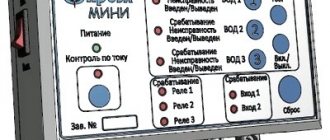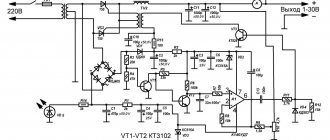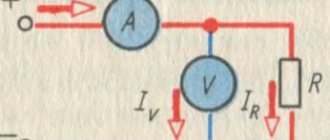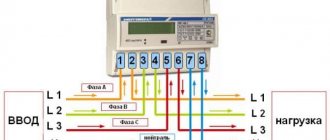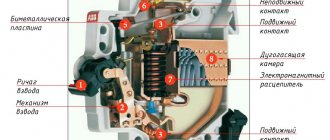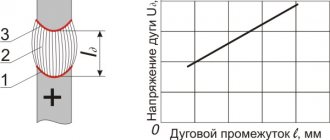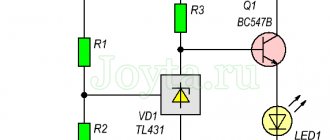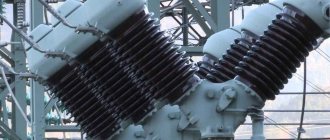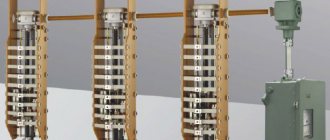- home
- electrical safety
- Electric arc
An electric arc is an electrical discharge in a medium (air, vacuum, SF6 gas, transformer oil) with high current, low voltage, high temperature.
This phenomenon is both electrical and thermal. May occur between two contacts when they are opened.
Let's look at the current-voltage diagram:
In this graph we have the dependence of current on voltage, a little not to scale, but it’s more clear. So there are three areas:
- in the first region we have a high voltage drop at the cathode and low currents - this is the glow discharge region
- in the second region, the voltage drop sharply decreases, and the current continues to increase - this is the transition region between the glow and arc discharge
- the third region characterizes the arc discharge - low voltage drop and high current density and therefore high temperature.
The mechanism for the occurrence of an arc can be as follows: the contacts open and a discharge occurs between them. During the opening process, the air between the contacts is ionized, acquiring the properties of a conductor, and then an arc occurs. Ignition of the arc is the process of ionization of the air gap, extinction of the arc is the phenomenon of deionization of the air gap.
Phenomena of ionization and deionization
At the beginning of the arc, ionization processes predominate; when the arc is stable, the ionization and deionization processes occur equally often; as soon as the deionization processes begin to dominate over the ionization processes, the arc goes out.
ionization:
- thermionic emission
- electrons are detached from the hot surface of the cathode spot; - field emission
- electrons escape from the surface due to high electric field strength. - Push ionization
- an electron flies out with sufficient speed and collides with a neutral particle along the way, resulting in the formation of an electron and an ion. - thermal ionization
- the main type of ionization, maintains the arc after it is ignited. The arc temperature can reach thousands of Kelvin, and in such an environment the number of particles and their speed increases, which contributes to active ionization processes.
deionization:
- recombination
- the formation of neutral particles from oppositely charged particles during interaction - diffusion
- positively charged particles are sent “overboard”, due to the action of the electric field of the arc from the middle to the border
There are situations when, when the contacts are opened, the arc does not light up, then they speak of a non-sparking break. This is possible at low current and voltage values, or when switching off at the moment when the current value passes through zero.
Arc. Conditions for the occurrence and burning of an arc. Arc extinguishing methods.
As shown in Fig.
1, the voltage on the arc is the sum of the cathode Uk and anode Ua voltage drops and arc barrel voltage Usd: Ud=Uk+Ua+Usd=Ue+ Usd. If a long arc, which occurs when the contacts are opened, is pulled into an arc-extinguishing grid of metal plates, then it will be divided into N short arcs. Each short arc will have its own cathode and anode voltage drop Ue. The arc goes out if:
Un Ue,
where U is the network voltage; Ue is the sum of the cathode and anode voltage drops (20-25 V in a DC arc).
An AC arc can also be divided into N short arcs. At the moment the current passes through zero, the near-cathode space instantly acquires an electrical strength of 150-250 V.
The arc goes out if
Un.
Arc extinction in narrow slots.
If an arc burns in a narrow gap formed by an arc-resistant material, then due to contact with cold surfaces, intensive cooling and diffusion of charged particles into the environment occurs. This leads to rapid deionization and arc extinction.
Rice. 4. Arc extinguishing methods:
a – division of a long arc into short ones; b – drawing the arc into a narrow slot in the arc-extinguishing chamber; c – rotation of the arc in a magnetic field; d – arc extinguishing in oil: 1 – fixed contact; 2 – arc trunk; 3 – hydrogen shell; 4 – gas zone; 5 – oil vapor zone; 6 – moving contact
Movement of an arc in a magnetic field.
An electric arc can be considered as a conductor carrying current. If the arc is in a magnetic field, then it is acted upon by a force determined by the left-hand rule. If you create a magnetic field directed perpendicular to the axis of the arc, then it will receive translational motion and will be pulled inside the slot of the arc-extinguishing chamber (Fig. 4, b).
In a radial magnetic field, the arc will receive rotational motion (Fig. 4, c). The magnetic field can be created by permanent magnets, special coils, or the circuit of current-carrying parts itself. Rapid rotation and movement of the arc contributes to its cooling and deionization.
The last two methods of extinguishing the arc (in narrow slots and in a magnetic field) are also used in disconnecting devices with voltages above 1 kV.
4. The main methods of extinguishing the arc in devices above 1 kV.
In switching devices over 1 kV, methods 2 and 3 described in paragraphs are used. 1.3. and the following arc extinguishing methods are also widely used:
1. Arc extinction in oil.
If the contacts of the disconnecting device are placed in oil, then the arc that occurs during opening leads to intense gas formation and evaporation of the oil (Fig. 4, d). A gas bubble is formed around the arc, consisting mainly of hydrogen (70-80%); rapid decomposition of the oil leads to an increase in pressure in the bubble, which contributes to its better cooling and deionization. Hydrogen has high arc-quenching properties. Contacting directly with the arc shaft, it contributes to its deionization. Inside the gas bubble there is a continuous movement of gas and oil vapor. Arc quenching in oil is widely used in circuit breakers.
2. Gas-air blast .
Arc cooling is improved if a directed movement of gases is created - blasting. Blowing along or across the arc (Fig. 5) promotes the penetration of gas particles into its barrel, intense diffusion and cooling of the arc. Gas is created during the decomposition of oil by an arc (oil switches) or solid gas-generating materials (autogas blast). It is more effective to blow with cold, non-ionized air coming from special compressed air cylinders (air switches).
3. Multiple current circuit break.
Switching off large currents at high voltages is difficult. This is explained by the fact that at high values of the supplied energy and recovery voltage, deionization of the arc gap becomes more difficult. Therefore, in high-voltage circuit breakers, multiple arc breaks are used in each phase (Fig. 6). Such switches have several extinguishing devices designed for part of the rated value.
yarn The number of breaks per phase depends on the type of switch and its voltage. In 500-750 kV circuit breakers there can be 12 breaks or more. To facilitate arc extinction, the recovery voltage must be evenly distributed between the breaks. In Fig. Figure 6 schematically shows an oil switch with two breaks per phase.
When a single-phase short circuit is disconnected, the recovering voltage will be distributed between the breaks as follows:
U1/U2 = (C1+C2)/C1
where U1,U2 are the voltages applied to the first and second discontinuities; C1 is the capacitance between the contacts of these gaps; C2 is the capacitance of the contact system relative to the ground.
Rice. 6. Voltage distribution over breaks in the switch: a – voltage distribution over breaks in the oil switch; b – capacitive voltage dividers; c – active voltage dividers.
Since C2 is significantly greater than C1, the voltage U1 > U2 and, consequently, the damping devices will operate under different conditions. To equalize the voltage, capacitances or active resistances are connected parallel to the main contacts of the circuit breaker (MC) (Fig. 16, b, c). The values of capacitances and active shunt resistances are selected so that the voltage at the breaks is distributed evenly. In switches with shunt resistances, after extinguishing the arc between the main circuits, the accompanying current, limited in value by the resistances, is broken by the auxiliary contacts (AC).
Shunt resistances reduce the rate of rise of the recovery voltage, which makes it easier to extinguish the arc.
4. Arc extinction in vacuum.
Highly rarefied gas (10-6-10-8 N/cm2) has an electrical strength tens of times greater than gas at atmospheric pressure. If the contacts open in a vacuum, then immediately after the first passage of the current in the arc through zero, the strength of the gap is restored and the arc does not light up again.
5. Arc extinction in high pressure gases.
Air at a pressure of 2 MPa or more has high electrical strength. This makes it possible to create fairly compact devices for extinguishing an arc in a compressed air atmosphere. The use of high-strength gases, such as sulfur hexafluoride SF6 (SF6 gas), is even more effective. SF6 gas not only has greater electrical strength than air and hydrogen, but also better arc-extinguishing properties even at atmospheric pressure.
DC Arc Properties
An arc can occur both with constant current-voltage and with alternating current. Let's start with the constant:
Anodic and cathodic areas
— size=10-4cm; total voltage drop=15-30V; tension=105-106V/cm; In the cathode region, the process of impact ionization occurs due to high voltage, the electrons and ions formed as a result of ionization form an arc plasma, which has high conductivity, this region is responsible for igniting the arc.
Arc barrel
— voltage drop is proportional to arc length; The current density is about 10 kA per cm2, due to which the temperature is about 6000 K and higher. Thermal ionization processes occur in this region of the arc; this region is responsible for maintaining combustion.
I-V characteristics of a DC arc discharge
This curve corresponds to curve 3 in the topmost figure. There is:
- Uз - ignition voltage
- Ug - quenching voltage
If the current is reduced from Io to 0 instantly, you will get a straight line that lies below. These curves characterize the arc gap as a conductor and show what voltage needs to be applied to create an arc in the gap.
To extinguish a DC arc, it is necessary that deionization processes prevail over ionization processes.
Arc Resistance:
- can be determined from the arc current-voltage characteristic
- active, regardless of the type of current
- variable quantity
- drops with increasing current
If you break the ammeter circuit under load, you can also see an arc.
ARC DISCHARGE
ARC DISCHARGE, independent quasi-stationary electrical discharge in gas, burning at almost any gas pressure exceeding 0.01–1 Pa (10–4–10–2 mm Hg), with a constant or varying low frequency (up to 103 Hz) potential difference between the electrodes. For D. r. characterized by a high current density at the cathode (102–108 A/cm2) and a low cathode potential drop, not exceeding the effective ionization potential of the medium in the discharge gap. For the first time D. b. between two carbon electrodes in the air was observed in 1802 by V. V. Petrov and independently of him in 1808 by G. Davy. The luminous current channel of this discharge, when the electrodes are horizontally positioned under the influence of convective flows, is bent in an arc shape, hence the names - D. r., electric. arc.
For the majority of D. r. at a high current density, a small, very bright spot appears on the cathode, moving over the entire surface of the cathode. The temperature in the spot can reach the boiling (or sublimation) temperature of the cathode material. Means. role in the mechanism of maintaining current D. r. Thermionic emission plays a role. A layer of positive space charge is formed above the cathode spot, which ensures the acceleration of emitted electrons to energies sufficient for impact ionization of atoms and gas molecules. Since this layer is very thin (less than the electron mean free path), it creates a high field strength at the cathode surface, especially near microinhomogeneities, therefore both field emission and thermal field emission are significant. The high current density and “jumping” of the spot from point to point create conditions for explosive electron emission.
From the zone of cathode potential drop to the anode there is the so-called. positive column. A bright anode spot usually forms on the anode, in which the surface temperature is almost the same as in the cathode. In some types of D. r. at currents of tens of amperes, torches appear on the cathode and anode in the form of plasma jets flying out at high speed perpendicular to the surface of the electrodes. At currents of 100–300 A, additional torches appear, forming a beam of plasma jets. Heated to a high temperature and ionized gas in the column is plasma. The electrical conductivity of a plasma can be very high, but it is usually only slightly higher. orders of magnitude lower than the electrical conductivity of metals.
When the concentration of charged particles is more than 1018 cm–3, the plasma state can sometimes be considered close to equilibrium. At lower densities, up to 1015 cm–3, a state of local thermodynamics may arise. equilibrium (LTE), when at each point of the plasma everything is statistical. distributions are close to equilibrium at one temperature value, which is different at different points. The only exception in this case is plasma radiation: it is far from equilibrium and is determined by the plasma composition and radiation rates. processes. With limited dimensions of the column D. r. even in dense plasma on the column axis, the LTE state is disrupted due to radiation. losses. This is expressed in a strong deviation of the plasma composition and the populations of excited levels from their equilibrium values. Kinetics of plasma in the column of D. r. at high densities it is determined mainly. collision processes, and as the density decreases (moving away from the axis), radiation plays an increasingly important role. processes.
Diameter of column D. r. determined by the conditions of the balance of emerging and lost energy. With increasing current or pressure, the loss mechanisms due to thermal conductivity of the gas, ambipolar diffusion, and radiation change. processes, etc. With such shifts, self-compression (contraction) of the column may occur (see Contracted discharge).
Depending on the combustion conditions of D. r. its parameters vary widely. Classic example D. r. – a direct current discharge burning freely in the air between carbon electrodes. Its typical parameters: current from 1 A to hundreds of amperes, distance between electrodes from millimeters to several centimeters, plasma temperature approx. 7000 K, anode spot temperature approx. 3900 K.
D. r. used as a laboratory light source and in technology (carbon arc lamps). D. r. with a carbon anode, drilled and filled with test substances, used in the spectral analysis of ores, minerals, salts, etc. D. r. used in plasmatrons, arc furnaces for smelting metals, electric welding, etc. electronic and lighting. devices T.n. a vacuum arc, which ignites in a vacuum and burns in metal vapor that has evaporated from the cathode, is used in vacuum high-voltage circuit breakers.
Structure and zone of the anode spot
There are 3 sections in the structure of the arc:
- Cathode spot. It is the site of acceleration and emission of electrons and has a negative charge. The size of this zone is approximately 1 micron (0.001 mm). 38% of the heat is released here, the voltage drop is 12-17 V.
- Arc pillar. Has a neutral charge because positive and negative particles are present in equal quantities. The average length is 5-10 mm. In this area, 20% of the heat is released and 2-12 V is lost.
- Anode spot. Bombarded with electrons, which gives it a concave shape (crater). The length of this zone is 10 µm. 42% of heat is released, 2-11 V is lost.
Structure and properties of the electric welding arc.
